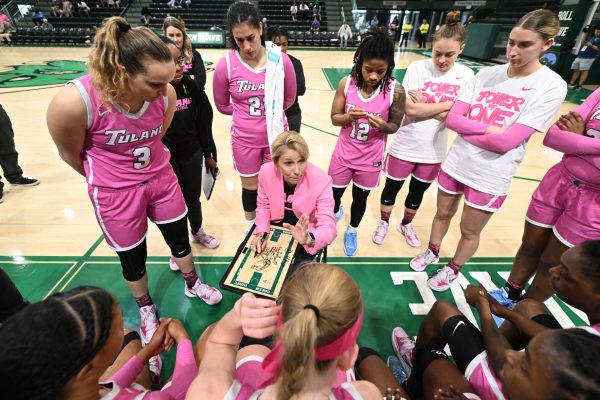Staff editorial: Students must embrace diversity, condemn intolerance
November 1, 2017
Many students awoke yesterday morning to find “It’s okay to be white” signs taped onto on-campus buildings. With other campuses across the nation experiencing similar occurrences, the aim of the fliers was clearly to incite outrage and provoke a response.
Though any response risks energizing these provocateurs, the peddling of hatred anywhere warrants forceful condemnation.
Crucially, however, even the fiercest denunciations often fail to get at the root of why the hanging up of these signs, and similar acts, are harmful to both students of color and the student body as a whole. In combating these efforts to sow division, we at Tulane must also answer the questions of those on whom the effect of these signs may be lost.
To these students, the declaration “It’s okay to be white” may appear to be simply a demonstration of ignorance or even an entirely benign, inoffensive assertion. By stating “It’s okay to be white,” however, the signs across campus revealed an underlying assumption: whiteness, in the view of those who put up these signs, is under attack. By placing these posters on the homecoming windows of multicultural organizations, they betrayed another telling assumption — a worldview that regards diversity as its antagonist.
Importantly, of course, Tulane University, even with its recent efforts to diversify, is far from a paragon of multiculturalism. Students of color constituted only 15.6 percent of the 2017 graduating class, despite being nearly 40 percent of the U.S. population in 2016. Minorities on campus, attending an institution named after a man who fought to deny them entry, continually struggle with this reality, whether in the classroom or in their social lives.
For many of these students, organizations such as the Tulane Black Student Union, Generating Excellence Now and Tomorrow in Education (GENTE) and the Indian Association of Tulane University provide a respite, albeit temporary, from their more permanent sense of marginalization. Those who posted these fliers early yesterday morning aimed to remove this security. Dressed in both Halloween costumes and cowardice, they adopted a false sense of victimhood. To them and those who share their sentiments, their status in society is threatened by the ascendancy of diversity.
As students of color and other marginalized groups have in recent years established groups and demarcated spaces in which to share their experiences, these initiatives have faced resistance and scrutiny. An inconvenient truth we must recognize, however, is that the experiences of students of color are far removed from those of white students on our campus. This is no admonition of white students, but it is nevertheless a truth which all must acknowledge, not avoid. Shaped by a tragic past and an imperfect present, this is something we as a university community must confront.
Diversity and acceptance are not zero-sum games. Each of us benefits when students of all backgrounds, regardless of their race, sexual orientation or socioeconomic status, feel not only safe but welcome on our campus. With one voice, then, we must both uplift the most marginalized among us and rebuke those who would silence them.
Staff Editorials are written weekly by members of the Tulane Hullabaloo Board and approved by the full Board by a 2/3 majority vote.






















David Brown • Nov 8, 2017 at 6:25 am
You call them cowards: “Dressed in both Halloween costumes and cowardice, they adopted a false sense of victimhood.” but I have heard reports that the police are after them for putting up these signs. Did I miss something? The only thing that comes to mind is that you didn’t know that when you wrote this.
This whole thing is weird to me. Like we are acting like it’s impossible for whites to be victims or experience racism. I’ve seen people get called out just for being white. I mean it’s not like I know what it’s like to have any other skin, but why are we calling them out for being white in this article? I feel like this is just separating people.
It can’t be healthy to claim they are racist for spreading a message of acceptance. I mean who are we to say what race it’s not alright to say this about? Isn’t that racist? The way I see it, we will never have equality by drawing this line in the sand. That is just adopting the tactics of hate groups and segregating people. We should be leading by example and showing people there’s another way.
I’m seriously worried that when people get called racist for this kind of thing it makes the word racism weak. Is the day coming, when we have the KKK rerouting members from this school because they think “Well, the racists I know just promote acceptance.”?
Reagan Thatcher • Nov 4, 2017 at 12:06 pm
It’s ok to be “______”. Fill in the blank. How does the statement not embrace diversity and condemn intolerance. It is no different than “Black lives matter” It IS ok to be white. If signs went up saying it is ok to be Latino – or black – or transgender, would TU be making the same statements? I doubt it. Once again, the same people who preach tolerance are the most INTOLERANT.
Jonah Kyle • Nov 4, 2017 at 11:08 am
And you guys fell for the hook, line, sinker, man, and the whole damn boat. This was simply a meme challenge put out by 4chan on Reddit whose aim was to provoke the negative response that it did. By interchanging “white” with any other non-white, diversity-inspiring racial construct that is typical in the “intersectional” movement, the test was to gauge the response to this meme. And the respondents failed in hilariously epic proportions.
The best way to have responded would have been to ignore the meme, or at least shrug it off with “eh.” If the respondents have done that, it would have added merit to their diversity campaign, which is now proven to being done to tribalize, not unite, people, which is the sad state of affairs.
In short, the entire diversity movement has essentially turned Martin Luthor King Jr. into a White Supremacist, with his “content of character over color of skin” racist nonsense.
Joanni Athens • Nov 2, 2017 at 7:22 am
Exactly what is wrong will stating “its okay to be white”? Would you also attack and condemn any signs put up stating ” its okay to be tan/yellow/black or blue” as a hate statement?
John Ardupak • Nov 2, 2017 at 4:09 am
So just to be clear, you think the phrase “It is okay to be white” is problematic?